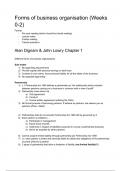Lecture notes
Company Law - Forms of Business Organisation - Full lecture notes, textbook readings, further readings
- Module
- Company Law (LAW6036)
- Institution
- Queen Mary, University Of London (QMUL)
Forms of Business Organisation - Weeks 1-2 - Company Law at Queen Mary University of London Part of a wider series of Revision Bibles, this note bible covers weeks 1 - 2. This includes lecture notes, textbook reading summaries, and additional / recommended reading which gave me a high 1st class ...
[Show more]



